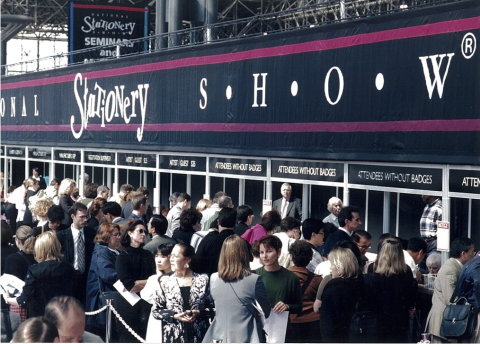National Stationery Show Survives by Staying in Step with Trends

In the 1940s, department stores were the primary retailers of most every item for daily life, including stationery and writing instruments. Tessie Goldwater, a buyer for May’s Department Stores, regularly attended gift shows in New York and Chicago, but felt there was a need for a more specialized paper goods show.
She approached Bill Little at George Little Management (now part of Emerald Expositions), urging that stationery, custom invitations, pens and related goods be given their own event. In 1945, the first New York Stationery Show was held in the New Yorker Hotel.
While those core product categories remain, numerous others have come and gone during the past 70 years. Gift wrap and tableware are now an important part of the show, and the card industry has blossomed with options for all kinds of occasions.
Halloween costumes and balloons were once part of the show, but no more. And the scrapbooking, rubber stamp, and sticker craze from a few years ago has scaled back, making way for the adult coloring book trend.
The show’s audience also has changed from those early days when it was mostly department store buyers. Now, in addition to those buyers, attendees come from all over the world representing both large and small retailers – museum stores, spas, pharmacies, boutiques, garden centers, and grocery stores – as well as online and mail order retailers, distributors, and event planners.
As a testimony to the relevance of the show, now known as the National Stationery Show (NSS), there are many longstanding exhibitors, including three who remain from that very first show: American Greetings, Freund-Mayer & Co. and Hallmark Cards.
While stationery also is present at gift shows, it doesn’t receive as much attention there. Patti Stracher, vice president and NSS show director, credits the endurance of the show to the fact that it offers very specific, focused content to buyers who are highly committed to the stationery category. They’re looking to discover new companies and trends and to meet and talk with the designer-makers.
“The NSS is a show where most of the product on display is new,” Stracher said. “It is a place to discover trending, quality products in a highly creative atmosphere.”
In fact, many companies launch their business at the show each year, she added.
The show has faced its share of challenges, including the “perfect storm” of 2008-2011 when economic issues combined with the digital revolution to drastically change the landscape of the stationery industry. Many of the designer-makers, as well as independent paper store retailers couldn’t survive.
But coming out the other side of that, the digital revolution has added more reasons to use paper products, Stracher points out.
“People are exhausted with the onslaught of digital communications and have a hunger for more personalized, authentic correspondence. Traditional paper products are keepsakes,” she said.
Dealing with the balance of traditional and digital communications is an ongoing challenge for the show as well. Stracher said that beautifully-designed traditional mailers that are reflective of the industry still are very important, but so is digital branding and marketing in order to reach a broader audience. And the NSS print directory isn’t going away any time soon.
Another challenging time was at the first show held at the Jacob K. Javits Convention Center in 1986, when the air conditioning failed and temperatures on the floor soared into the 90s.
Jack Withiam, show manager at the time, turned off the air conditioning in his fourth-floor office as well, so when exhibitors came to complain they found an office that was hotter than the showfloor!
Several special features have been announced for the celebration of 70 years:
- NSS launched “Stationery Stories,” a series of profiles on the show’s website and social media channels that tell about the people who made the industry and show what it is today.
- Mohawk Fine Papers, official paper of the NSS 2016, will display a selection of rare historic items from The Strathmore Archives at the show in May.
- Visual presentation and design students from the Fashion Institute of Technology (FIT) are collaborating with NSS to create a gallery-style display for finalists in the Best New Product Competition.
This year’s show is on track to have 800 exhibitors and 10,000 attendees filling 100,000 net square feet at the Javits.


Add new comment